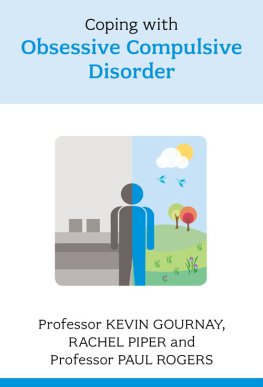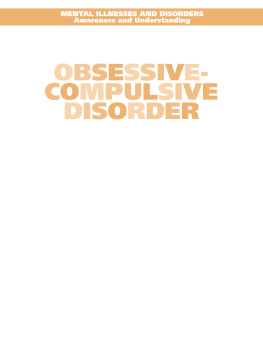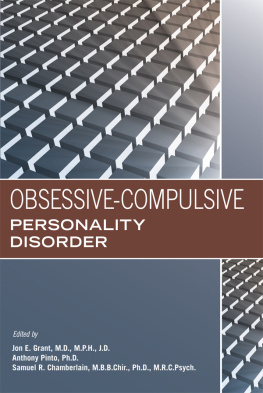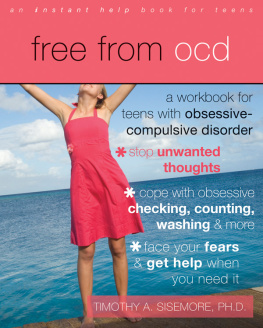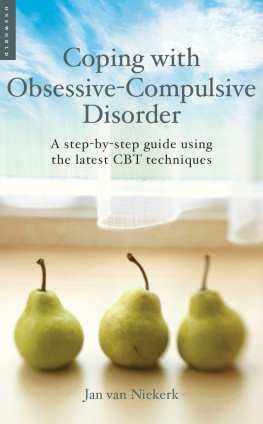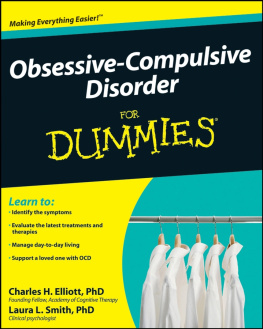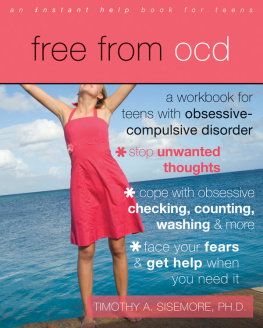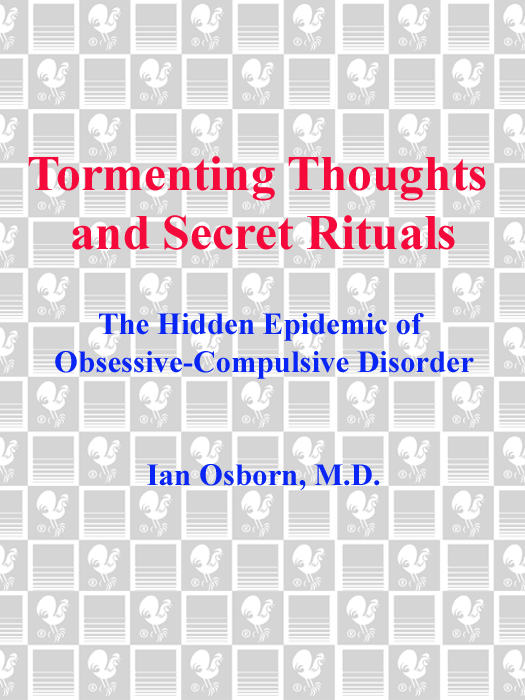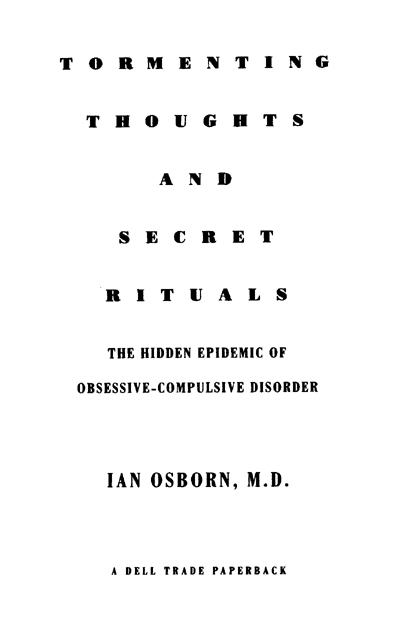Praise for
TORMENTING THOUGHTS AND SECRET RITUALS
AN INVALUABLE RESOURCE for OCDers, their families, and treating professionals He takes the reader into the lives of OCD sufferers with detailed, vivid case studies that are at the same time poignant and cause for great hope.
Michael R. Lowry, M.D., author of Major Depression, Prevention and Treatment
Covering resources available to the OCD sufferer, Osborn illuminates this once mysterious disorder clearly for both professional and lay readers, helping to dispel the miasma of shame and fear that has plagued so many for so long.
Publishers Weekly
AN EXCELLENT JOB
very realistic and useful strategies for combating OCD.
Gail Steketee, Ph.D., Boston University School of Social Work
Blending case histories from his practice with intriguing bits of history and biography, Dr. Osborn has provided both the general and professional reader with a helpful and engrossing account of this serious disorder.
Ronald Pies, M.D., clinical professor of psychiatry, Tufts University School of Medicine
I heartily recommend this beautifully written book to all sufferers of OCD.
Lee Baer, Ph.D., author of Getting Control: Overcoming Your Obsessions and Compulsions, director of research, OCD Unit, Massachusetts General Hospital, associate professor of psychology, Harvard Medical School
The first book on OCD for the lay person that gives a detailed look at what is known about the causes of this troubling disorder. Dr. Osborns literary and historical references make it a unique and valuable contribution to the literature on OCDas much for the seasoned professional OCD treatment provider as for the sufferers and their families. Truly up-to-date information on research and resources an essential book in the library of everyone who has ever suffered from OCD, or cared for an OCD sufferer.
Carol Novak, M.D., director, The Pioneer Clinic
A VERY READABLE ACCOUNT The book should enable those who have suffered in silence from this often debilitating condition to experience less shame and confusion and encourage them to seek help.
Martin Marder, Ph.D.
THE BEST BOOK OF ITS KIND currently available An exceptionally fine book for persons with obsessive-compulsive disorder and their families. Because he not only treats but suffers from OCD himself, he brings a unique perspective and understanding to his writing. Richly illustrated with case materials from the authors extensive experience, the book provides detailed, up-to-date information on diagnosis and treatment.
Russell Noyes, Jr., M.D., professor of psychiatry, University of Iowa
OCD sufferers will find this book both practical and informative Interesting to reada quality that many self-help books lack. A book which I will be able to recommend to my patients.
Fred Penzel, Ph.D.
An outstanding book for clients, their families, therapists, and researchers on the assessment and treatment of OCD A superb job on providing readers with a highly readable, very informative and well-balanced book on this important topic. I would highly recommend it to colleagues, clients, and families of OCD sufferers.
Larry Michelson, Ph.D., professor of psychology and director of the Stress and Anxiety Disorders Institute, Penn State University
A DELL TRADE PAPERBACK
Published by
Dell Publishing
a division of
Random House, Inc.
1540 Broadway
New York, New York 10036
Grateful acknowledgment is made to the following for permission to reprint previously published material: American Psychiatric Association: Excerpts from the Diagnostic and Statistical Manual of Mental Disorders, Fourth Edition. Copyright 1994 by the American Psychiatric Association. Archives of General Psychiatry: The Yale-Brown Obsessive-Compulsive Scale by Goodman, Rasmussen, et al. Archives of General Psychiatry, vol. 46, 1989, pp. 10061011. Copyright 1989 by the American Medical Association.
Reprinted by permission of Archives of General Psychiatry. Elsevier Science Ltd.: The Padua Inventory by Ezio Sanario. Behavior Research and Therapy, vol. 26, no. 2, 1988, pp. 16977. Reprinted by permission of Elsevier Science Ltd., Oxford, England.
Copyright 1998 by Ian Osborn, M.D.
All rights reserved. No part of this book may be reproduced or transmitted in any form or by any means, electronic or mechanical, including photocopying, recording, or by any information storage and retrieval system, without the written permission of the Publisher, except where permitted by law. For information address: Pantheon Books, New York, New York.
The trademark Dell is registered in the U.S. Patent and Trademark Office.
eISBN: 978-0-8041-5083-5
Reprinted by arrangement with Pantheon Books
Published simultaneously in Canada
v3.1
These things may seem ridiculous to others, even as ridiculous as they were in themselves, but to me they were the most tormenting cogitations.
J OHN B UNYAN ,
Grace Abounding to the Chief of Sinners
CONTENTS
Appendix A The Yale-Brown
Obsessive-Compulsive Scale
PROLOGUE:
A PERSONAL PERSPECTIVE
I suffered obsessive-compulsive disorder myself while in medical training. Terrifying, tormenting thoughts often popped unbidden into my mind, causing surges of panic and piercing discomforts. The thoughts usually took the form of vibrant, violent images, for instance, of a knife being thrust into my flesh, or of my nose being scraped right off in a car accident. A particularly frequent one was that of my hand being punctured by a phlebotomy needle. I would have the sudden, intrusive image of me standing at a patients bedside ready to draw a sample of blood: I unsheath a large-bore phlebotomy needle, menacing, daggerlike in its appearance, and then inexplicably, instead of inserting the needle into my patients vein, I thrust it to the hilt into the thenar eminence of my hand. Upon the occurrence of this frightful fantasy, my hand would ache in a manner that seemed indistinguishable from genuine pain. I would shake it to make it feel better.
It was fortunate that these troublesome intruders into my consciousness rarely struck when I was engaged in important activities and that therefore they did not upset my medical career because they were impossible to fend off. The more I resisted them, the worse they became. I often used counter-ideas, or restorative images, to neutralize them. To counteract the phlebotomy-needle thought, I would imagine an impenetrable cream covering my hand. The needle would strike and promptly burst into pieces. The image would fade. Yet the tormenting fantasy would always return at another time.
What I suffered, I learned later, was a typical form of obsessive-compulsive disorder. My tormenting thoughts were obsessions, and my counteractive ideas were compulsions. I know now that by fearing them and fighting them, I only made them worse. But back then I didnt know any better.
What did I do for help? Since I later went on to study psychiatry, youd think that I might have gotten therapy: probed into my unconscious, teased apart my ego defenses, scrutinized my childhoodat the very least, come to some sort of an understanding of my problem. Nothing of the sort. When my obsessions were not bothering me, I didnt want to think about them. I kept my tormenting thoughts a secret, as most OCDers do. Given the treatments that were available back then, it was probably just as well.



